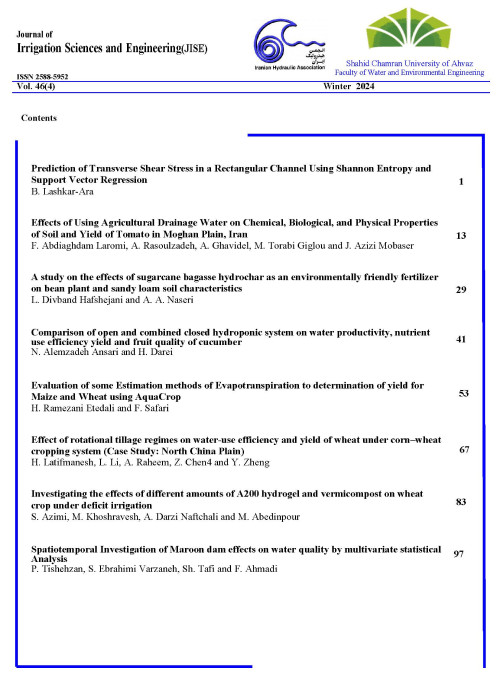Estimation of Unsaturated Soil Hydraulic Conductivity Using Inverse Approach Under Soil Salinity Condition
Author(s):
Article Type:
Research/Original Article (دارای رتبه معتبر)
Abstract:
Moisture flow through unsaturated zone is vital in agricultural engineering, soil science, groundwater hydrology, and environmental engineering. Moisture flow through unsaturated zone is complex due to the dependencies of flow and storage properties on the pressure head and is commonly analyzed by solving Richards’ equation. Solution of Richards’ equation requires the knowledge of soil hydraulic conductivity and water content versus pressure head functions referred to herein as the soil hydraulic properties. Since these functions are highly nonlinear, direct laboratory and field measurements are tedious, time consuming, and involve considerable uncertainty (Hari Prasad et al., 2010). An alternative to the direct determination is to employ the parameter estimation methods using inverse procedure for the determination of hydraulic properties. Indirect methods are divided into several categories, including methods based on pedotransfer functions, semi-physical, and inverse methods (Abbasi, 2007). Determination of hydraulic properties by inversion of in situ measured moisture contents, pressure heads and cumulative infiltration have become an alternative to direct measurements due to decrease in the computational costs and development of efficient optimization algorithms. Inverse solutions based on the Richards’ equation are now increasingly used for estimating the unsaturated soil hydraulic properties. The HYDRUS-1D model is one of the advanced models have been widely used to simulate one-dimensional water movement in soil. Examples of numerical studies in which infiltration data were used to inversely estimate the near-saturated soil hydraulic properties using HYDRUS model are by Simunek and van Genuchten (1996) and Rashid et al (2015). Water quality can impact on soil hydraulic conductivity changes. The effect of salinity on the hydraulic conductivity of soil has been studied by many researchers, including Moutier et al. (1998) et al. and Levy (2005). The researchers reported that increasing the salinity has increased the hydraulic conductivity of the soil. The purpose of this research was to evaluate saline water effect on unsaturated hydraulic properties and estimate these properties inversely using infiltration data.
Keywords:
Language:
Persian
Published:
Irrigation Sciences and Engineering, Volume:41 Issue: 3, 2018
Pages:
133 to 144
magiran.com/p1904188
دانلود و مطالعه متن این مقاله با یکی از روشهای زیر امکان پذیر است:
اشتراک شخصی
با عضویت و پرداخت آنلاین حق اشتراک یکساله به مبلغ 1,390,000ريال میتوانید 70 عنوان مطلب دانلود کنید!
اشتراک سازمانی
به کتابخانه دانشگاه یا محل کار خود پیشنهاد کنید تا اشتراک سازمانی این پایگاه را برای دسترسی نامحدود همه کاربران به متن مطالب تهیه نمایند!
توجه!
- حق عضویت دریافتی صرف حمایت از نشریات عضو و نگهداری، تکمیل و توسعه مگیران میشود.
- پرداخت حق اشتراک و دانلود مقالات اجازه بازنشر آن در سایر رسانههای چاپی و دیجیتال را به کاربر نمیدهد.
In order to view content subscription is required
Personal subscription
Subscribe magiran.com for 70 € euros via PayPal and download 70 articles during a year.
Organization subscription
Please contact us to subscribe your university or library for unlimited access!


